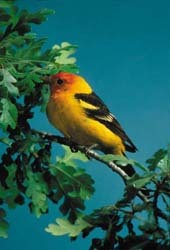Western Tanager
Backyard Tips
Although they don’t typically eat seeds, Western Tanagers may eat dried fruit, freshly cut oranges, and other fresh fruit at bird feeders. If you live in a wooded area within this bird’s range, providing moving water or a birdbath or pond may help attract them to your yard.
Cool Facts
- While most red birds owe their redness to a variety of plant pigments known as carotenoids, the Western Tanager gets its scarlet head feathers from a rare pigment called rhodoxanthin. Unable to make this substance in their own bodies, Western Tanagers probably obtain it from insects in their diet.
- This species ranges farther north than any other tanager, breeding northward to a latitude of 60 degrees—into Canada’s Northwest Territories. In the chilly northernmost reaches of their breeding range, Western Tanagers may spend as little as two months before migrating south.
- Male Western Tanagers sometimes perform an antic, eye-catching display, apparently a courtship ritual, in which they tumble past a female, their showy plumage flashing yellow and black.
- The oldest Western Tanager on record—a male originally banded in Nevada in 1965—had lived at least 6 years and 11 months by the time he was recaptured and rereleased during banding operations in Oregon in 1971.
- This information was provided from www.allaboutbirds.org

